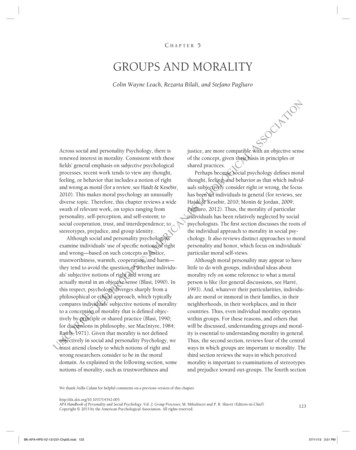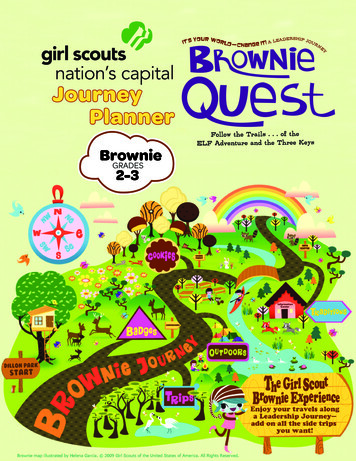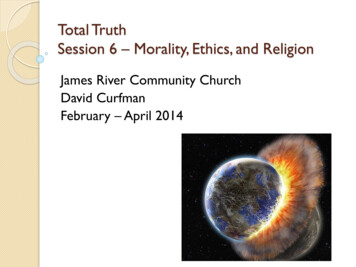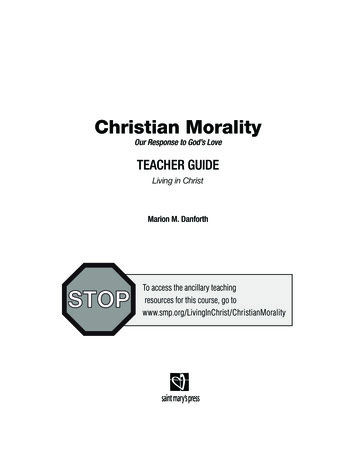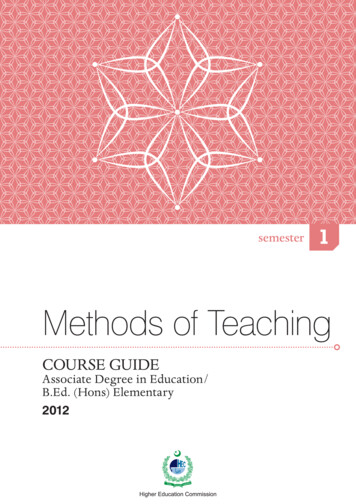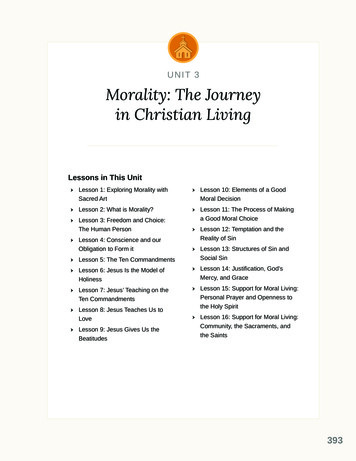
Transcription
UNIT 3Morality: The Journeyin Christian LivingLessons in This Unitӹӹ Lesson 1: Exploring Morality withSacred Artӹӹ Lesson 10: Elements of a GoodMoral Decisionӹӹ Lesson 2: What is Morality?ӹӹ Lesson 11: The Process of Makinga Good Moral Choiceӹӹ Lesson 3: Freedom and Choice:The Human Personӹӹ Lesson 4: Conscience and ourObligation to Form itӹӹ Lesson 12: Temptation and theReality of Sinӹӹ Lesson 5: The Ten Commandmentsӹӹ Lesson 13: Structures of Sin andSocial Sinӹӹ Lesson 6: Jesus Is the Model ofHolinessӹӹ Lesson 14: Justification, God’sMercy, and Graceӹӹ Lesson 7: Jesus’ Teaching on theTen Commandmentsӹӹ Lesson 15: Support for Moral Living:Personal Prayer and Openness tothe Holy Spiritӹӹ Lesson 8: Jesus Teaches Us toLoveӹӹ Lesson 9: Jesus Gives Us theBeatitudesUni t 3 O v erv iewӹӹ Lesson 16: Support for Moral Living:Community, the Sacraments, andthe Saints393
Scripture Studied in this Unitӹӹ Genesis 1:1-3ӹӹ Ezekiel 36:26-27ӹӹ John 8:43-45ӹӹ Genesis 3:6ӹӹ Matthew 5:11-17ӹӹ Romans 6:8ӹӹ Exodus 19:4-6ӹӹ Matthew 6:22-2ӹӹ Exodus 20:2ӹӹ Matthew 19:21ӹӹ 1 Corinthians 13:1213ӹӹ Deuteronomy 6:3ӹӹ Matthew 22:37-40ӹӹ Galatians 5:1ӹӹ Joshua 24:15ӹӹ John 1:14ӹӹ Galatians 5:13ӹӹ Psalm 16:3ӹӹ John 1:17ӹӹ Ephesians 4:25ӹӹ Psalms 51:3-4ӹӹ John 4:14ӹӹ Hebrews 4:15ӹӹ Psalm 107:28-30ӹӹ John 8:12ӹӹ 2 Peter 3:11ӹӹ Sirach 15:17ӹӹ John 8:31-32ӹӹ 1 John 1:8Connection to the Catechism of the Catholic ChurchLesson 1ӹӹ 1777, 1802Lesson 2ӹӹ 1749, 1954, 1956Lesson 3ӹӹ 1700-1715, 17301742Lesson 4ӹӹ 1776, 1778, 17831785, 1792, 2039Lesson 5ӹӹ 2052-2082Lesson 6ӹӹ 50-73, 456-483394Lesson 7ӹӹ 577-582, 19501986, 2054-2055,2084-2141, 21972257Lesson 12ӹӹ 391-395, 402-409,413-421, 538-540,566, 1808, 2113,2119, 2157, 2340Lesson 8ӹӹ 1805-1845Lesson 13ӹӹ 1849-1876, 19391942Lesson 9ӹӹ 1716-1729, 19651986Lesson 10ӹӹ 1749-1761Lesson 11ӹӹ 386, 1755-1756,1780, 1849Lesson 14ӹӹ 1987-2005Lesson 15ӹӹ 687-688, 25592565, 2725-2741Lesson 16ӹӹ 770-771, 777-780,830-856, 960-962 S OP H IA IN S TITU TE FOR TE A C H ERS
IntroductionGod created us for happiness. He willsnothing more than that we share in Hisown blessedness, and it is for this purposethat God created us in His image andlikeness. To be created in the image of Godmeans that we have intellect, free will andthe capacity to love. When we exercise ourfreedom for the sake of loving God and oneanother we become like Him. The gift offreedom is thus a capacity God gives to usin order to make our life a gift to others.To Be Holy is to Love as God LovesAnother word that captures this humanvocation to love is holiness. To be holy is tolove as God loves. Indeed, Christians oftenoverlook the fact that Jesus elevated andperfected the golden rule, which states,“Do unto others whatever you would havethem do to you.” (Matthew 7:12). By makingHis free self-offering on the Cross — thecomplete revelation of divine love and themeasure of Christian discipleship — Heis able to give us a new commandment:“that you love one another, even as I haveloved you, that you also love one another.By this all men will know that you are mydisciples, if you have love for one another”(John 13:34). This is the whole meaning ofChristian morality — to use our freedom forthe sake of charity, for self-gift.As Christ shows us, charity makes manydemands of us and can only be expressedin truth. True and mature Christian charityrecognizes that certain acts are eviland to be avoided because they destroyour relationship to God, our self, or ourneighbor. Christian maturity is moved towhat is good by the truth and beauty of God.Original SinBecause of sin, however, to love as Godloves is not easy. Original Sin fragments theorder and wholeness God established in thebeginning. The challenge of becoming likeGod in holiness, therefore, is most evident inthe experience of sin and the woundednessthat follows. Through sin we impair ourThis is the whole meaningof Christian morality — touse our freedom for the sakeof charity, for self-gift.The Denier Caesar, by Philippe de ChampaigneUni t 3 O v erv iew395
capacity for love by abusing our freedom andusing it for selfish purposes, even while deepwithin our conscience we also experienceGod calling us to a deeper faithfulness andobedience to the light of truth.Sacred Scripture reveals the profounddepth of God’s mercy in dealing with theproblem of human sin. Therein, SalvationHistory tells the story of how God giveshumanity a variety of helps to assist uson our path to holiness. We need thesehelps because of the weakness with whichOriginal Sin affects us.The first of these helps is God’s law bywhich he guides us toward the way of life(Deuteronomy 30:19). God’s law was firstwritten on stone tablets at Mount Sinai andthen written anew on our hearts throughthe indwelling of the Holy Spirit at Baptism.The second help God gives us is among thefirst fruits of our Baptism, namely, the seedsof those virtues that build us up in holiness,especially faith, hope, and charity. Byinfusing within us the virtues of Christianliving, God empowers us to live as childrenof light (Ephesians 5:8) who for freedomhave been set free from sin (Galatians 5:1).God’s Greatest Gift to UsThese forms of assistance that God givesto us would not amount to much, however,without the redemption won for us by JesusChrist. This is God’s greatest gift to us.Through His life and Death, Suffering andResurrection — the Paschal Mystery — Jesushas not only exemplified perfect holinessof life, but He has also opened for us awellspring of grace and has given “power396to become children of God” (John 1:3). Jesussaid of Himself “I am the way, and the truth,and the life” (John 14:6). In becoming oneof us, and in being tempted in every waybut without ever consenting to sin, the Sonof God opened humanity up to the innerlife of God’s eternal love (Hebrews 4:15). Inbecoming flesh, the Word of God has raisedhuman nature up to divine life (2 Peter 1:4).This is why we call Christian morality “Lifein Christ.”Living Life in ChristA key to living in Christ and receivingthis life as a gift is prayer. Prayer is howwe meet the gaze of our loving Saviorwho longs to renew us from within andrelease us from the bondage of sin. Whenwe encounter Him in prayer, the DivinePhysician heals our interior wounds,insecurities and weaknesses.The liturgy offers us the supremeopportunity for this communion with God.All the Sacraments are an invitation fromChrist to encounter His love and receivethe spiritual nourishment that renewsus and restores us to the happiness forwhich God made us and the fullness of life.The Sacrament of the Eucharist holds aprivileged place in Christian discipleship,as does the Sacrament of Reconciliation.By these two fonts of grace, the divinelife of Christ is built up in us and draws usmore deeply into the Trinity’s own innerlife of blessedness. It is into this most holyplace that Jesus calls us when He asks us tofollow Him. The challenge of the moral lifeis simply to respond generously to His call. S OP H IA IN S TITU TE FOR TE A C H ERS
Connections to New YorkReligion GuidelinesThemeThrough our relationship with Jesus, wegrow in an ever-deepening awarenessof who we are, and how to live. CatholicChristian morality gives direction to ourresponse to God’s call.Objectivesӹӹ To help the young adolescent growin an understanding of the moralresponsibilities arising from one’srelationship with Jesus.ӹӹ To help the young adolescentunderstand what conscience is and howto form his or her conscience accordingto the Catholic faith.Content Overviewӹӹ Definition of moralityӹӹ The Basis of Catholic morality in the lifeand teaching of Jesus Jesus’ relationship with God theFather Jesus’ teaching on theCommandments Jesus’ teaching on love Jesus’ vision of the Kingdom Jesus’ invitation to His Disciplesӹӹ Learning to choose Fundamental choices Definition of conscience The Development of conscienceӹӹ To help the young adolescent learnbasic concepts of morality and developskills for moral decision-making. Elements of a moral decisionӹӹ To enable the young adolescent torecognize the role of the Spirit and thewitness and guidance of the CatholicChristian community in moral living. Dealing with temptation The process of making a good moralchoice Failure to choose the good as Godsees itӹӹ The Supports for moral living Personal prayer and openness to theHoly Spirit The witness of the community Sacraments as nourishment andstrength The Communion of SaintsUni t 3 O v erv iew397
Vocabularyӹӹ Conscienceӹӹ Agapeӹӹ Endӹӹ Moralityӹӹ Erosӹӹ Relativismӹӹ Free Willӹӹ Storgeӹӹ Consequentialismӹӹ Human actionӹӹ Philiaӹӹ Artifactӹӹ Responsibilityӹӹ Virtueӹӹ Concupiscenceӹӹ Voluntaryӹӹ Faithӹӹ Intellectӹӹ Freedomӹӹ Hopeӹӹ Willӹӹ Choiceӹӹ Charityӹӹ Fallen Natureӹӹ Human personӹӹ Prudenceӹӹ Temptationӹӹ Christian Anthropologyӹӹ Temperanceӹӹ Mortal Sinӹӹ Hierarchyӹӹ Fortitudeӹӹ Venial Sinӹӹ Formationӹӹ Justiceӹӹ Personal Sinӹӹ Obligationӹӹ Beatitudeӹӹ Social Sinӹӹ Lawӹӹ Happinessӹӹ Capital Sinsӹӹ Typeӹӹ Sermon on the Mountӹӹ Justificationӹӹ Decalogueӹӹ Graceӹӹ Mercyӹӹ Commandmentӹӹ Blessingӹӹ Meritӹӹ Revelationӹӹ Moralӹӹ Sanctifyӹӹ Perfectionӹӹ Objectӹӹ Meritӹӹ Holinessӹӹ Ontologicalӹӹ Prayerӹӹ Abolishӹӹ Intentionӹӹ Covenantӹӹ Fulfillӹӹ Circumstancesӹӹ Communionӹӹ Divine Legislatorӹӹ Goodӹӹ Holy Spiritӹӹ Corporalӹӹ Evilӹӹ Churchӹӹ Spiritualӹӹ Sinӹӹ Ecclesiaӹӹ Works of Mercyӹӹ Meansӹӹ SacramentPacing GuideAim to begin in Unit 3 in February.398 S OP H IA IN S TITU TE FOR TE A C H ERS
Exploring Morality with Sacred ArtUNIT 3, LES S ON 1Learning GoalsConnection to theCatechism of theCatholic Churchӹӹ Jesus is the light of the world and theway, the truth, and the life.ӹӹ By following Jesus, we attain the lightof life.ӹӹ CCC 1777ӹӹ CCC 1802ӹӹ Through Jesus we can come to theFather.Vocabularyӹӹ Listening to our consciences brings usto God.ӹӹ ConscienceB IB L ICAL TOUCHSTONE SIn the beginning, when God created theheavens and the earth — and the earth waswithout form or shape, with darkness over theabyss and a mighty wind sweeping over thewaters — then God said: Let there be light, andthere was light.Jesus spoke to them again, saying, “I am thelight of the world. Whoever follows me will notwalk in darkness, but will have the light of life.”JOH N 8 :12GE NE S I S 1: 1-3Uni t 3, l e sson 1399
Lesson PlanMaterialsӹӹ Handout A: Ancient ofDaysӹӹ Teacher Resource: LightCardsDAY ONEWarm-UpMy NotesA. Project an image of the painting on Handout A:Ancient of Days. Give students several minutes toquietly view the art before you say or ask anything.Allow them to come up and stand closer to theimage to examine the details.B. Once several minutes have passed, ask students:ӹӹ Biblical Touchstonesӹӹ What do you first notice about this work of art?ӹӹ What do you like about it?ӹӹ Have you ever seen paintings like this? Where?ӹӹ How would you describe this painting?C. Explain that “Ancient of Days” is a title for God theFather from the book of Daniel. Read aloud Daniel7:13-14:As the visions during the night continued, I sawcoming with the clouds of heavenOne like a son of man.When he reached the Ancient of Daysand was presented before him,He received dominion, splendor, and kingship;all nations, peoples and tongues will serve him.His dominion is an everlasting dominionthat shall not pass away,his kingship, one that shall not be destroyed.400ActivityArrange students in small groups and give each groupa laminated copy of Handout A: Ancient of Days. Havethem discuss the questions on the back of the handoutwith each other. During this time, try to keep studentsfocused on the artwork and the discussion questions,letting their conversations go in unexpected ways. S OP H IA IN S TITU TE FOR TE A C H ERS
Formative AssessmentA. Circulate among the groups, listening to their discussion, keeping them on task, andoffering insights or clarification where needed.B. Before moving on to the next activity, have each group write one question they wouldask the artist about his work and turn it in.DAY TWOWarm-UpProject an image of Ancient of Days on Handout A, and read aloud a few of the mostinteresting questions offered by the student groups the previous day. Allow students toshare their reactions and other personal responses to the art.ActivityA. Give students copies of the art, and have them skim over the questions they discussedthe previous day. Then call on groups in turn to share their answers to each of thequestions. Conclude the discussion with the question of how the artist probably wantedthe people who viewed his painting to feel.B. Ask if anyone has ever heard the expression “See the light.” What do we mean when wesay someone has seen the light? Ordinarily it means that the person has recognized thetruth.C. Project and read aloud John 8:12 and John 14:16:Jesus spoke to them again, saying, “I am the light of the world. Whoever follows mewill not walk in darkness, but will have the light of life.”Jesus said to him, “I am the way and the truth and the life. No one comes to theFather except through me.”D. Help students focus on the verses by asking these questions:ӹӹ What are all the things that Jesus is telling us that He is? Light, way, truth, and life.ӹӹ In John 8:12, what does Jesus promise us? He promises us the light of life.ӹӹ What must we do to have the light of life? Follow Jesus.ӹӹ In John 14:16, to whom does Jesus say we can come? The Father.Uni t 3, l e sson 1401
Lesson Plan (continued)ӹӹ Through whom must we come to the Father? Go through Jesus.E. Ask students now to compare and contrast the verses. They are similar in that they bothtell us that Jesus is the way to Heaven. Both speak of our going somewhere or attainingsomething with Jesus’ help. The goals of life and being with the Father are similar becausethe Father created and gave us life. Contrasts include that the first advises us to followJesus and the second advises us to go through Him. The first emphasizes our journey offollowing Jesus, and the second emphasizes the destination of being with the Father.F. If needed, define the word metaphor: a type of figurative language that uses one thing tostand for another. When Jesus says He is the light of the world, He doesn’t mean literallight; He means to use the word light in a fuller way.G. Before class, copy and cut out the cards on Teacher Resource: Light Cards. Distributeone card to each student. Ask students to read the verses and answer the questions.Formative AssessmentAsk students to begin to connect what they have been discussing to the idea of morality.What does it mean to “see the light” when it comes to moral choices? Have studentsdiscuss this question with a neighbor, while you circulate around the room offeringsuggestions or questions to prompt their recognition of God as the source of truth andmorality.DAY THREEWarm upA. Project and read Genesis 1:1-3, John 8:12 and Catechism no. 1802:In the beginning, when God created the heavens and the earth — and the earth waswithout form or shape, with darkness over the abyss and a mighty wind sweepingover the waters — then God said: Let there be light, and there was light.Jesus spoke to them again, saying, “I am the light of the world. Whoever follows mewill not walk in darkness, but will have the light of life.”The Word of God is a light for our path. We must assimilate it in faith and prayer andput it into practice. This is how moral conscience is formed.402 S OP H IA IN S TITU TE FOR TE A C H ERS
B. Ask students to compare Genesis 1:1-3 and John 8:12. In what two ways is light spokenof in relation to God? In the passage from Genesis, God created light; in the passage fromJohn, God is light and He gives light.C. Project again an image of Ancient of Days. Ask students:ӹӹ How does this painting illustrate that God is light and is the Creator of light? Acceptreasoned answers.ӹӹ How does this painting help you visualize that God gave us our consciences? Acceptreasoned answers.ӹӹ How does this painting help you visualize that God gives us His light in ourconsciences so that we can follow Him and come to Him? Accept reasoned answers.Activity and AssessmentPope St. John Paul II strongly encouraged that the faithful memorize important passages ofScripture. In the Apostolic Exhortation Catechesi Tradendae, he wrote: “The blossoms.offaith and piety do not grow in the desert places of memoryless catechesis.” When studentshave memorized important Scripture passages, the Word of God resides in their minds andhearts and is at the ready when a student needs it.To respond to Pope St. John Paull II’s wish, have your students write out and commit tomemory some or all of the following Bible verses, which complement all the lessons inthis unit. Give students a few minutes each day to study them and practice recitation andwriting. Before completing this unit, select one or two of these verses to have studentswrite out from memory as a quiz at the end of the unit. Use the Blank Copywork Page atthe beginning of the book for these memorization quizzes. You may also choose to haveyour students recite some or all of the memorized Scripture.This copywork activity is but one means of helping students commit Scripture to memory.Encourage your students to explore other means of memorization, such as hangingimportant Scripture verses on their refrigerator at home, or on their bathroom mirror,reciting and discussing Scripture with their parents, using passages in conversation, andother creative means of use and memorization. Students should also be able to identify thework of art in this lesson.ӹӹ Jesus spoke to them again, saying, “I am the light of the world. Whoever follows mewill not walk in darkness, but will have the light of life.”–J OHN 8 : 12Uni t 3, l e sson 1403
Lesson Plan (continued)ӹӹ Jesus said to him, “If you wish to be perfect, go, sell what you have and give to [the]poor, and you will have treasure in heaven. Then come, follow me.–M ATT HE W 19 : 2 1ӹӹ For freedom Christ set us free; so stand firm and do not submit again to the yoke ofslavery.–GA L AT I A N S 5 : 1ӹӹ “The lamp of the body is the eye. If your eye is sound, your whole body will be filledwith light; but if your eye is bad, your whole body will be in darkness. And if the lightin you is darkness, how great will the darkness be.”–M ATT HE W 6 : 2 2-23ӹӹ Now, if you obey me completely and keep my covenant, you will be my treasuredpossession among all peoples, though all the earth is mine. You will be to me akingdom of priests, a holy nation.–E XODU S 19 : 5 -6ӹӹ Because while the law was given through Moses, grace and truth came throughJesus Christ.–J OH N 1: 17ӹӹ “Do not think that I have come to abolish the law or the prophets. I have come not toabolish but to fulfill.”–M ATT HE W 5 : 17ӹӹ “You shall love the Lord, your God, with all your heart, with all your soul, and withall your mind. This is the greatest and the first commandment. The second is like it:You shall love your neighbor as yourself. The whole law and the prophets depend onthese two commandments.”–M ATT HE W 2 2 : 37-4 0ӹӹ “Blessed are you when they insult you and persecute you and utter every kind ofevil against you [falsely] because of me. Rejoice and be glad, for your reward will begreat in heaven.”–M ATT HE W 5 : 11-12ӹӹ If we say, “We are without sin,” we deceive ourselves, and the truth is not in us.–1 J OH N 1: 8404 S OP H IA IN S TITU TE FOR TE A C H ERS
ӹӹ If, then, we have died with Christ, we believe that we shall also live with him.–ROM A N S 6 : 8ӹӹ Jesus answered and said to her, “Everyone who drinks this water will be thirstyagain; but whoever drinks the water I shall give will never thirst; the water I shallgive will become in him a spring of water welling up to eternal life.”–J OHN 4 : 14Uni t 3, l e sson 1405
Ancient of DaysB Y W I LLI A M B L A K E ( C. 1 7 9 4 )British Museum, London.DIGITAL IMAGES AVAILABLE ATWWW.SOPHIAINSTITUTEFORTEACHERS.ORG406 S OP H IA IN S TITU TE FOR TE A C H ERS
HANDOUT AAncient of DaysAncient of Days, by William Blake (c. 1794)Directions:Take some time to quietly view and reflect on the art. Let yourself be inspiredin any way that happens naturally. Then think about the questions below, anddiscuss them with your classmates.Conversation Questions1. Who is depicted in this painting?2. Read Genesis 1:1-3. How does this painting help you visualize this passage fromScripture?In the beginning, when God created the heavens and the earth and the earth waswithout form or shape, with darkness over the abyss and a mighty wind sweepingover the waters — Then God said: Let there be light, and there was light.3. Why do you think God created light first of all the things He created?4. Read John 8:12. What does Jesus promise?Jesus spoke to them again, saying, “I am the light of the world. Whoever follows mewill not walk in darkness, but will have the light of life.”5. What did Jesus call Himself? How does this painting help you visualize and understandJesus’ words?6. Read paragraph 1802 from the Catechism. How would you put this in your own words?“The Word of God is a light for our path. We must assimilate it in faith and prayerand put it into practice. This is how moral conscience is formed.” How would youput this in your own words?7. Who and/or what is the Word of God?8. According to this passage, what does the Word of God do, and what must we do? S O P HI A IN ST IT U T E F OR T E AC H E R S407
9. Moral conscience is God’s voice in our hearts, judging what is right and wrong andurging us to do what is right and avoid what is wrong. How are our consciences formedand given light by God’s Word?10. Why do you think God gave you a conscience?408 S OP H IA IN S TITU TE FOR TE A C H ERS
TEACHER RESOURCELight CardsDirections:Copy and cut out the following cards, enough to hand out one to eachstudent. Have students read the verse and answer the questions.Psalm 119:105Your word is a lamp for my feet, a light for my path.1.This passage describes what as light?2. Why do you think that this is described as light?John 1:3-5All things came to be through him, and without him nothingcame to be. What came to be through him was life, andthis life was the light of the human race; the light shines inthe darkness, and the darkness has not overcome it.1.This passage describes what as light?2. Why do you think that this is described as light?Uni t 3, l e sson 1409
John 3:21But whoever lives the truth comes to the light, so thathis works may be clearly seen as done in God.1.Who does this verse say will come to the light?2. Why do you think living in truth shows that one is acting in God?1 John 1:5, 7Now this is the message that we have heard from him and proclaimto you: God is light, and in him there is no darkness at all. If we walkin the light as he is in the light, then we have fellowship with oneanother, and the blood of his Son Jesus cleanses us from all sin.1.This passage describes whom as light?2. How do you think living in God’s light is connected to being cleansed of oursins?410 S OP H IA IN S TITU TE FOR TE A C H ERS
Ephesians 5:8-9For you were once darkness, but now you are light in theLord. Live as children of light, for light produces everykind of goodness and righteousness and truth.1.In whom do we become light?2. How do you think a life of light produces goodness, righteousness, and truth?Uni t 3, l e sson 1411
Answer KeyHandout A: Ancient of Days1.God2. Accept reasoned answers.3. Accept reasoned answers.4. Jesus promises that whoever follows Him will not walk in darkness but have the light oflife.5. Accept reasoned answers.6. Accept reasoned answers.7. Jesus and Scripture/the Bible.8. The Word of God lights our path. With faith and prayer, we are to live according toGod’s Word.9. Our moral consciences are formed when we bring the Word of God into our lives withfaith, prayer, and in practice.10. Accept reasoned answers.Teacher Resource: Light CardsPsalm 119:1051 John 1:5, 71.1.God’s WordGod2. Accept reasoned answers.2. Accept reasoned answers.John 1:3-5Ephesians 5:8-91.1.Life2. Accept reasoned answers.The Lord2. Accept reasoned answers.John 3:211.Whoever lives the truth2. Accept reasoned answers.412 S OP H IA IN S TITU TE FOR TE A C H ERS
What Is Morality?UNIT 3, LES S ON 2Learning Goalsӹӹ Objective truth exists; right and wrongexist.Connection to theCatechism of theCatholic Churchӹӹ Morality is the quality of our actionswhereby they are right or wrong.ӹӹ CCC 1749ӹӹ Actions that are in accordance withGod’s law and will are right.ӹӹ CCC 1956ӹӹ Because we are free, we are morallyresponsible for our actions.ӹӹ CCC 1954Vocabularyӹӹ Moralityӹӹ Free Willӹӹ Human actionӹӹ Responsibilityӹӹ VoluntaryChastity StrandB IB L ICAL TOUCHSTONE SIf it is displeasing to you to serve the LORD,choose today whom you will serve, the godsyour ancestors served beyond the River or thegods of the Amorites in whose country you aredwelling. As for me and my household, we willserve the LORD.Jesus said to him, “If you wish to be perfect, go,sell what you have and give to [the] poor, andyou will have treasure in heaven. Then come,follow me.MAT T H EW 19:21J OS H UA 24 : 15Uni t 3, l e sson 2413
Lesson PlanMaterialsӹӹ Handout A: What IsMorality?ӹӹ Handout B: The RichYoung Manӹӹ Handout C: Subjective orObjective?My Notes414DAY ONEWarm-UpA. Ask the class, “What is morality?” and keep a simplelist on the board of student responses. Acceptreasoned answers.B. Explain that sometimes a good way to describe adifficult concept is to say what it is not. Ask yourstudents to describe what morality is not, and keepa simple list on the board. Accept reasoned answers.Then propose the following list of things morality isnot (if they were not brought up in the discussionbefore).ӹӹ Morality is NOT a list of things to do and not todo.ӹӹ Morality is NOT a limiting of your freedom.ӹӹ Morality is NOT a list of things the Churchteaches to keep people obedient.C. Conclude by emphasizing that morality is muchmore than a list of do’s and don’ts.ActivityDistribute Handout A: What Is Morality? and work as aclass to complete it by analyzing the definition adaptedfrom the Catholic Encyclopedia.Formative AssessmentA. Write this summary definition of morality from theCatechism no. 1749 on the board for reinforcementand discussion:“Freedom makes man a moral subject. When heacts deliberately, man is, so to speak, the fatherof his acts. Human acts, that is, acts that are S OP H IA IN S TITU TE FOR TE A C H ERS
freely chosen in consequence of a judgment of conscience, can be morally evaluated.They are either good or evil.”B. Have students write a definition of morality in their own words.DAY TWOWarm-UpA. Have students read aloud some of their definitions of morality from yesterday.Correct mistakes, and remind them of what morality is not as you reinforce a morecomprehensive understanding.B. Call on individual students to answer the following questions, and discuss as a largegroup (see the answer key to Handout A for guidance).ӹӹ How does one conform to a standard?ӹӹ What are voluntary actions?ӹӹ Are we responsible for voluntary actions?ӹӹ What is someone’s character?ӹӹ What is the relationship between human action and character?C. Without naming its source, write on the board the famous quotation from MartinLuther King Jr.’s “I Have a Dream” speech:“I have a dream that my four little children will one day live in a nation where theywill not be judged by the color of their skin, but by the content of their character.”Ask if anyone can identify who said it.D. Explain that King was not a Catholic, but a Baptist (Christian) minister. Was he sayingthat he wanted to live in a world where we did not judge others? No.E. How did King describe the correct way to judge others? Not by the color of their skin, butby the content of their character.F. Emphasize that this quotation shows King’s recognition that right and wrong exist. Asour society becomes less willing to “judge” others, we become less willing to standup for what is right, and we become less just as a society. A just society requires thathuman beings exercise judgment by making good moral choices. We can know whatgood moral choices are by learning about God and His commands. We can also knowUni t 3, l e sson 2415
Lesson Plan (continued)them, although not as completely, through our own reason, because His commands areof the natural law. The natural law applies to everyone, everywhere, and is not affectedby time or place.ActivityA. Distribute Handout B: The Rich Young Man and read aloud the story from Matthew19:16-26. On the handout, students should use the Bible story to make a list of standardsby which one can judge his actions.B. Conclude that actions that are in accordance with God’s law and will are right, and thatwhat Christ is asking for is not merely rule-following, but detachment from worldlythings so that treasure may be gained in Heaven.Formative AssessmentDraw on the board a diagram like this:Measure Our ActionsAs a class, fill in sources of measurement on thesix lines. Emphasize that what Jesus describesto the rich young man is a set of standards bywhich we can measure our actions and whichindicate not mere rule-following, but the habitsof character that enable us to do the right andgood thing to store up treasure in heaven.DAY THREEWarm-UpA. Begin by letting the class know that you will tell a story. Students should listen carefullyand stand up when they hear someone in the story contradict himself or herself. Thestory goes:Jane and her mother were arguing about euthanasia (or killing someone out of adesire to end that person’s suffering). Jane’s mother pointed out that euthanasiaends an innocent human life and therefore is wrong. Jane said that there is no such416 S OP H IA IN S TITU TE FOR TE A C H ERS
thing as right or wrong for everyone. If a person believes that euthanasia is murder,then eutha
in Christ." Living Life in Christ A key to living in Christ and receiving this life as a gift is prayer. Prayer is how we meet the gaze of our loving Savior who longs to renew us from within and release us from the bondage of sin. When we encounter Him in prayer, the Divine Physician heals our interior wounds, insecurities and weaknesses.



